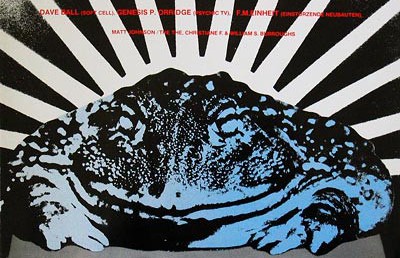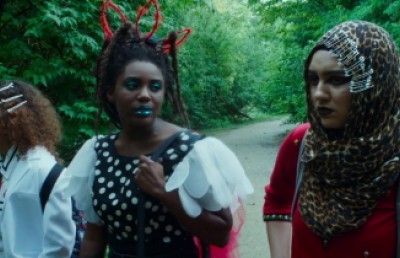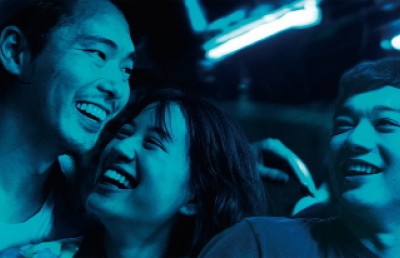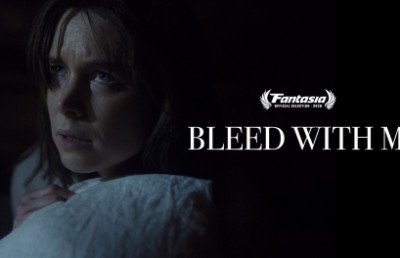Fantasia 2019: A Report from the Front lines
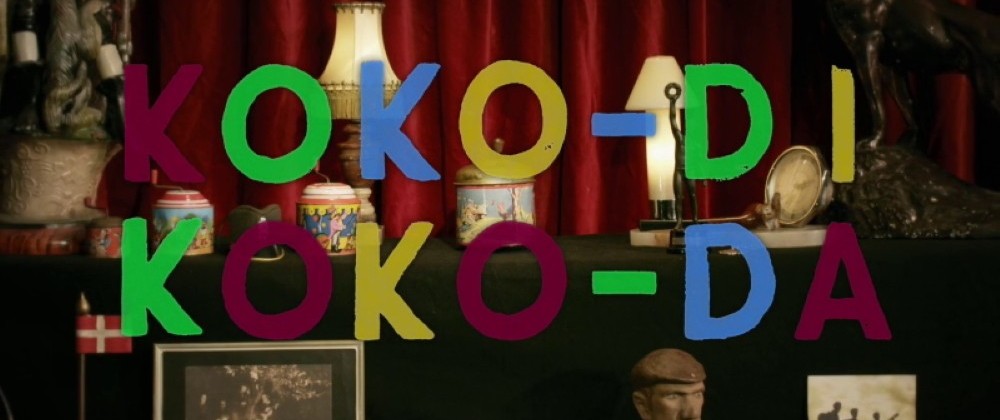
At the 1999 Fantasia Film Festival I watched the North American premiere of Ring (Hideo Nakata, 1998) with friends visiting from England, Stacey and Simon. Flash forward twenty years, almost to the day, and I anxiously await the North American premiere of Nakata’s next installment in the “Ring” saga, Sadako, with my friends visiting from England, Stacey and Simon! Unfortunately, Sadako did not have the same impact as Ring, hampered by an identity crisis –is it a reboot, origin story, sequel? Thankfully, over the same twenty-year span Fantasia has grown in industry importance, organizational strength and fiscal responsibility, spearheaded by an ever more viable film market, consistently good programming that blends easy to digest entertainment with more challenging genre fare. Even as it grows, Fantasia remains a film festival run by cultured cinephiles who get a charge when a film they programmed connects with an audience. The Fantasia audience is a unique beast, boisterous, supportive and respectful of filmmakers presenting their works, but not afraid to interject irony or self-mockery (cue cat meow).
As a member of AQCC I was heading a jury, along with colleagues Andrew Todd and Elijah Baron, of the Camera Lucida section, which is known for its “edgier” selections, often including films that stretch the outer limits of what people expect to see at a “genre” film festival. This year was no exception, with Letters to Paul Morrissey (Armand Rovira, Saida Benzal 2018, Spain), a 16mm, black & white essay film which uses a series of fictitious letters written to experimental filmmaker Paul Morrissey that range from autobiographical to free form to poetic; and Night God (Adilkhan Yerzhanov, Kazakhstan, 2019), a rigorously controlled, claustrophobic pre-apocalyptic world, with an organic mise en scène which underscores the inertia of its politically oppressed characters.
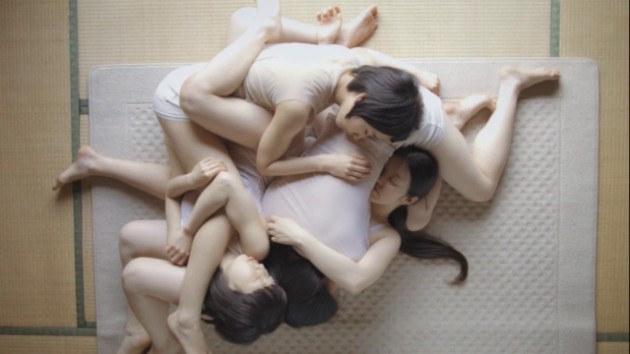
Hottamura Days
As a jury we awarded a special mention to the collection of four short films by young Japanese director Nao Yoshigai, for her unique ability to represent the sensuous properties of the natural world with filmed synesthesia. The four shorts are Stories of the Floating Wind (9 min.), The Pear and the Fang (30 min.), Hottamaru Days (2016, 38 min.) and The Grand Banquet (2019, 15 min.) The most enchanting of the shorts is Hottamura Days, which sees a teenage girl channel her fantasies and desires through a quartet of embodied nymphs. Ok I know I need to prefix that this is coming from a male perspective, but Hottamura Days is one of the purest expressions of feminine fantasy I’ve seen on screen. A bespectacled teenage girl lies asleep in her country cottage. Her space is shared by four like-minded, similarly physiqued nymphs, all dark haired wearing provocative white lacy undershirts and tight white underwear. In a striking overhead shot the four bodies are intertwined as one, then begin to move and slither over and under each other, smelling, sucking, and blowing imaginary air on each other. Since nymphs are associated with air, sea, and water, the camera sometimes delves underwater following them on their journey above and below. In an enigmatic scene, one of the nymphs is gorgeously lit in a corner of the house, in silhouette with haze streaming all around her, as she slowly dances, stretching her body and contorting it. Her movements are silent. This cuts to a striking close-up of the occupant, as if coming out of her head space. She gives out a blow which then cuts to an underwater shot of a nymph swimming.
In a scene which shifts the tone to comedy, the four nymphs scour the house for dead skin, hair and fingernails, offering them up into a ritualistic pile. During much of this time the glasses wearing ‘dreamer’ is asleep which gives this its oneiric touch. In the showcase scene, the occupant encircles the nymphs holding a bass drum, beating it in unison to the dancing. The image is gelled to red. The camera is constantly tracking around them; she begins to whisper sing; the space color changes to night blue; the drumming gets harder and faster; the effect is hypnotic. The ‘battle’ (if reading the use of the same drum beat) carries over to a small bathtub, where two nymphs caress each other then try to drown each other under the water. One appears victorious and exits the tub. The drumming stops. She looks at the three other nymphs (is this the occupant, who maybe has killed one of the nymphs, or replaced her?) then leaves the house for the green space around her house. She appears in extreme long shot running around as if in joyous freedom. The film ends on this very long take of her jumping down below the tall grass and above. Then she runs toward the camera, which cuts to black.
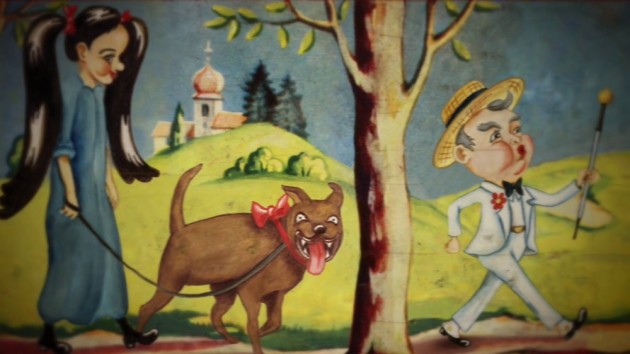
KoKo-Di KoKo-Da
We awarded our main prize to Koko-Di, Koko-Da (Johannes Nyholm, 2019, Sweden/Denmark), a tale of grief and healing staged as a faux folklore of shadow puppetry and live action. Married couple Tobias (Leif Edlund) and Elin (Ylva Gallon) traumatized by the loss of their young daughter relive a bizarre recurring nightmare in the woods which has them continually attacked by a trio of sadistic troubadours. The story is prefixed by a fairy tale coda of the sadistic group of three people, Mog (Peter Belli) an elderly man dressed in all white, a big brutish man carrying a dead white dog, a tall, sulking pony-tailed women and a second robust dog, walking through the forest. The dead dog comes back later in one of the mini-narratives, creating a looping narrative. These characters feature as part of the film’s fairy tale aspect, as they are seen painted on a children’s toy music box, and indirectly feature in some of the animated interludes which reflect on the tragic death of the daughter. The story picks up three years after the death of their 8 year-old daughter, with the couple driving to a camping vacation. During the night Elin leaves the tent to urinate and is attacked the merry group of three, who beat and possibly rape her. They track back to the tent, where the dog is set into the tent to attack Tobias. They leave. We cut back to Elin peeking out the tent, telling Tobias she needs to go to the bathroom. And the nightmare plays out again, six more times with variations each time (Tobias usually coming out of it as somewhat a coward). In one version the eerie white cat who seems to be leading the travellers leads a woman, not Elin from the beginning, to a cabin deep in the woods, where she sees play out an animated version of the story, with bunnies pulling strings. Each story ends with a God’s Eye high angle shot of the violent group encircling the tent and victims, with a feint blurring masking the contours of the image.
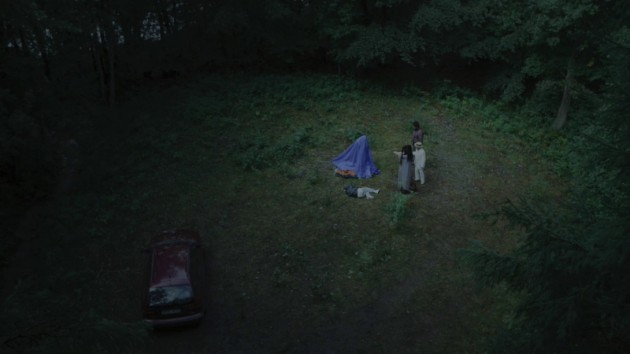
KoKo-Di KoKo-Da
The sound is always ominous in these shots. In some versions it appears Tobias is with another woman, implying he left Elin. In the final version of the nightmare the couple are driving away and hit the white dog seen dead in the brute’s arms, sending it flying upwards, with the car careening off the road into a huge puddle. The couple embrace and console each other with cries and kisses. The film ends on a celestial image of the daughter; the camera tracks toward her body floating in a black void. We hear the music box motif that has played throughout and is associated with the sadistic forest travelers. The camera dollies around to reveal the daughter, dressed as she was in the opening in bunny makeup, winding up a round music box with the three travelers painted on the box in bright, playful colors. A slow dissolve brings us closer into a panning shot of the drawings, which reveal each of the characters and dogs in exaggerated cartoon style drawings, with the catchy song playing, “Koko-Di Koko-Da” a Nordic children song written for the film. The final scene suggests that it has been the daughter all along who has “pulled the strings” of the events that have tortured her parents. Think Antichrist meets Run Lola Run meets Groundhog Day!
Other standouts in the Camera Lucida program were Les particules (Swiss, France, Blaise Harrison, 2019), equal parts coming-of-age drama, science-fiction film, and metaphysical mystery which raises serious philosophical questions about the limits of human knowledge.
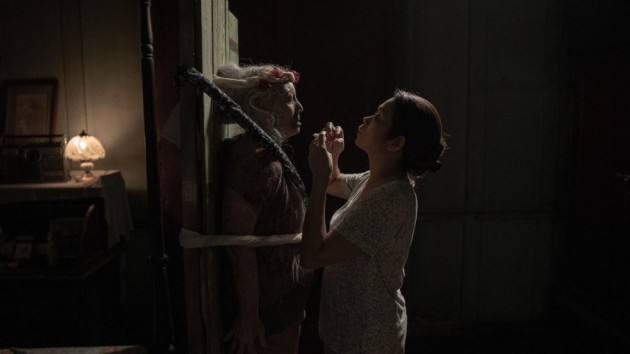
Ode to Nothing
And there is Ode to Nothing (Dwein Baltazar, Philippines, 2018), an Ozu styled story about a middle-aged funeral home worker whose mounting loneliness, social alienation and financial pressures lead to a surreal tapestry of murder, madness and ghostly delusions. Sonya ( Marietta Subong, aka Pokwang) is a 44 year-old woman who has taken over a slumping funeral parlor business from her father Rudy (Joonee Gamboa), who spends his time in solitude, putting his daughter in servitude. Sonya seems to care less for the living, who only pressure her for money (loan-shark landlord Theodor, played by Dido de la Paz), or refuse her sexual advances (young street vendor Elmer, played by Anthony Falcon), so when the unclaimed corpse of an elderly woman comes into her care, she begins to treat the corpse as her living mother. She talks to her, cares for her, and protects her.
Ode to Nothing’s slow descent into mild madness is cued with a rigorous formal control of static long takes, frame within frames that keep Sonya imprisoned in the space of the funeral home, old academy aspect ratio of 1.33:1, empty spaces, muted browns and tans (no bold colors) with planned use of movement (a series of pans at the end) and series of close-up jump cuts that momentarily break the formal control. Sonya is constantly framed through doorways, window frames, iron bars, and mostly tight framings. With the use of static long takes there must be an influence of Lav Diaz but as I cited earlier, the story of aging daughter caring for her father while feeling the years pass by evokes Ozu, especially An Autumn Afternoon (1964), as well as the visual style. In an interview the DP Neil Daza said they strictly used a 25mm lens, which parallels again Ozu, who used a 50mm lens for his later films. The formal control seems programmed to keep the viewer glued to the intense performance by Marietta Subong as the 40 something Sonya, who feels trapped by her social standing and familial responsibility. In the first scene where we get to really meet her, she comes across as uncaring to a woman making funeral arrangements and trying to get a discount on the basis that she is doubling business by bringing her two deaths (her father died three hours after her mother). Sonya replies, make it three and I’ll throw in the flowers for free, which causes the woman to scorn her and leave. Sonya comes across as a crass businesswoman with absolutely no bedside manners, but when we get to know more about her predicament —lonely, living with a non-responsive father, behind in her bills, sexually needy, and intimidated by a landlord Theodore who repossesses furniture and threatens to take over the land bill if she does not make her payments— we begin to empathize with her.
Two men drop off the corpse of an unidentified old lady, and give Sonya money with no questions asked. Something about the lady touches Sonya, who treats the corpse but begins to lavish love on her and treats her as if she were her mother (who we assume is dead). Sonya is sensitive to issues of aging, worries about still being sexually attractive and hates when people refer to her as “madame”. Actress Pokwang is 58 but plays 44. She tries to come on Elmer, the snack food vendor selling a Philippine drink called Taho made of soft tofu, arnibal, a brown sugar syrup, and sago pearl, and eventually invites him in when he is felled by a car and needs care to a knee wound. She tries to kiss him but is rebuffed. Later when he dies in an accident and brought to her by his wife, she cries and shows more grief than she ever has.
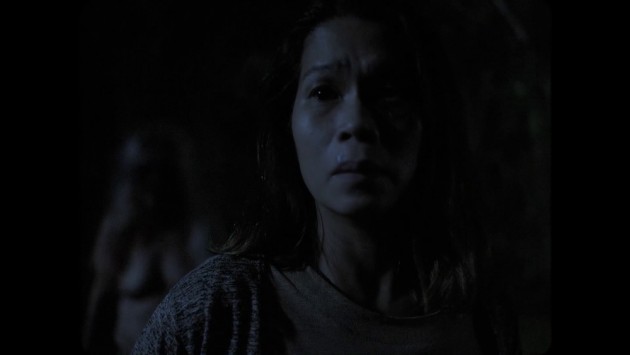
Ode to Nothing: the final shot
Sonya blames the corpse (her ‘mother’) for Elmer’s death, bestowing jealousy on her in a side-way allusion to Psycho (the overbearing mother who still commands after death). Her attachment to the corpse lady grows stronger. She brings her to bed, washes her, speaks to her, shares her Walkman with her, and then seems to ‘hear’ her voice giving her hidden knowledge about a buried stash. She digs deep in her front yard and finds a bag filled with money (a mortician communicating with the dead recalls last year’s Nightshift). But when she offers the money to her debtor, he angrily rejects what is a bag of torn paper. Did Sonya imagine the money? Or did it somehow change to paper? Does the corpse have powers or is everything in her mind? The fact that Baltazar never shows us a clear sign of the supernatural outside Sonya’s subjectivity, we must assume the latter. Which makes this slow descent into madness an emotionally impactful example of ‘mind fuck’ cinema. Because the style has been so meticulously focused on Sonya, a life suffocated by an emotionally dead father, corpses and grieving people, we feel her emotional isolation. A slow track back from Sonya sitting at her desk feels relentless and fateful. She never seems to have time for the truly living. Her father seems on board with her living illusionism, treating the arguments Sonya has with the corpse as family squabbling. After the revelation that the money is just paper, she again blames the ‘mother’ and knocks off her head with the force of the money bag against her head. In a gut wrenching gesture she picks up the head, caresses it and cries her heart out, “I’m sorry”. Once the ‘money’ vanishes for good, in both her mind and in reality, Theodore tells them he will take over the business and that she has to leave with her father. They prepare their escape. The father buries the corpse. They sit quietly over a last supper. They pack and leave. She steals the hearse and drives away into an uncertain future. When they take a stop on the side of the road for a smoke, we get the second panning movement in the film, from Sonya leaning on the car to the woods, and the image of a nude old white-haired woman walking through the woods. (An earlier pan took us from Sonya to her off-frame father.) Movement is introduced as her world begins to crumble. She follows after the corpse into the dark woods. A series of close-up jump cuts on her pivoting head adds a sense of freedom of instability and randomness previously non-existent. The final image is a close-up on Sonya looking forward past the camera, but the viewer can make out the out of focus corpse of the old woman behind her. Sonya senses the presence, in her face we see recognition. As she begins to turn the shot fades to black, to nothing. Balzatar leaves us in the limbo land of the pure fantastic (as explained in Tzvetan Todorov’s seminal book of literary theory, The Fantastic: A Structural Approach to a Literary Genre (1973).
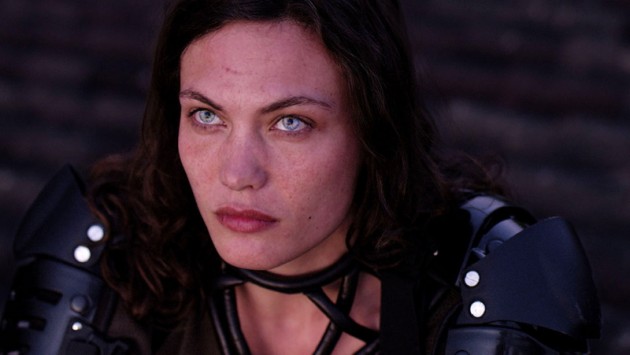
Jessica from Jessica Forever
Also of interest is Jessica Forever (2019, France, Caroline Poggi, Jonathan Vinel), a first feature that artfully explores a parable about the limits of nurturing love, with a near future dystopia where orphans are hunted down for their inherent violent nature in a set-up scenario that echoes “Lord of the Flies” and Claire Denis’ Beau Travail (the homoerotic all-male world, non-linearity, images of beautiful young men doing quotidian acts). While orphans —only boys it appears— are hunted down by lethal drones, a young, angelic looking woman named Jessica (tall, slim and lanky Aomi Muyock), roves the streets protecting the orphans and inviting them into her surrogate ‘family’, which consists of about 10 young men who are all beholden to the quiet power of Jessica. She rules with her gorgeous blue-green eyes and a platonic love, plus the occasional material gift. They take refuge on an island, in an ultra-modern, comfortable home, shopping, exercising, taking communal naps, listening to music together and feeding off each other’s karma.
As a unit they keep each other in check, but when left alone they are prey to their violent nature, or personal demons. Lucas (Augustin Raguenet), for example, is haunted by the astral ghost of the gorgeous younger sister he murdered, Andrea (Angelina Woreth). The first visitation occurs in a poetic underwater scene where she appears with her golden hair and bright red suit illuminating the sea. Other times she appears and disappears as flickering particles, recalling a similar effect of disappearance in Les particules.
Lucas is sometimes persuaded by Michael (Sebastian Urzendowsky) to wonder off looking for contact with locals, which often leads to violent eruptions. On a trip to the beach Michael meets a beautiful woman Camille (Maya Coline), which leads to the only sex scene in the film. When one of the younger, more sensitive members of the surrogate family is rebuffed by Raiden (Paul Hamy), the young man burns himself alive. The gesture signals the end of their family, as Raiden sees the act as indication that they will always be monsters, no matter how much Jessica loves and protects them. Even though Jessica Forever is clearly at the level of parable, there are lapses in logic or clarity which confuse what the parable is about. How did these kids become orphans? If the parable has social import, this would seem an important point. Orphans of what? Of proper parenting? As a generation reared on video games, where violence is a way of life? When one says in VO that some of them kill for “food and some for pleasure”, what does that mean? If they are hunted orphans, how can they shop freely in supermarkets? Without the assured hand of someone like Claire Denis, some of the formal posturing veers very close to pretention. The finale echoes Wild Bunch, as the group prepare for a fight to the end, as they know Raiden’s murder of two locals on the beach will spur the authorities to action. Thematically, A Clockwork Orange is invoked (once through direct music cue) in that all humanity, even these orphans, have something to be saved and hunting them down like animals is an inhumane act. The final two shots represent the clash of unnamed authority, a black sea of drones, and humanity, Jessica and her family, dressed in all military style black, lined up waiting for the attack to begin. A Clockwork Orange, Beau Travail, Wild Bunch, Lord of the Flies. It adds up to a heady if unfocused cocktail of dystopian commentary on youth culture, violence, engagement and authority.
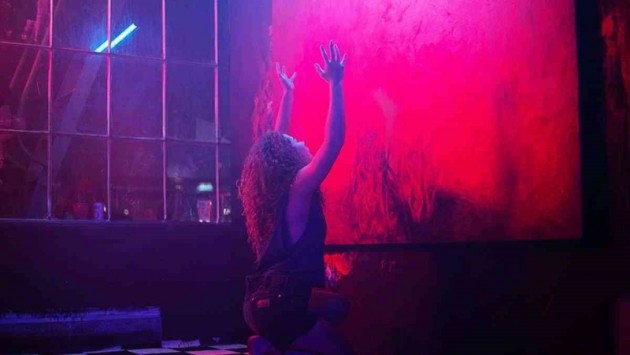
Bliss
One of my favorite ‘experiences’ at Fantasia 2019 was the intoxicating blend of psychedelic arthouse horror, Bliss, by Joe Begos. With the 700+ Hall Building in full sync, Bliss was akin to a heavy metal psychedelic experience in the guise of an urban noir, vampire film. The film has more energy than 1000 Red Bulls. Dora Madison is exhausting as conceptual visual artist Dezzy, who is having trouble finishing off a painting for an upcoming show. She’s having a bad day, or maybe week. Her agent drops her; the art gallery owner waiting on her piece and landlord are nipping at her behind; while her occasional boyfriend/drug dealer Clive (Jeremy Gardner) and friends try to help her out, but drinking and drugging don’t make things any smoother for Dezzy. About 25 minutes into the film Dezzy imbibes some of the ‘bliss’ and the film kicks into pycho-manic overdrive mode with dolly-rig shots, zoom shots, 360 degree camera moves, spinning dance scenes, lesbian sex, color saturation, flicker madness and sonic bursts of music of all types, from heavy metal to ambient. In between the madness Dezzy stares at her large incomplete Dantean Inferno-inspired canvas which only fuels her nightmarish visions, ending in a manic nude body art painting climax where her art confronts the slithering bodies of her personal demons/victims before consuming Dezzy’s own body and soul into its canvas.
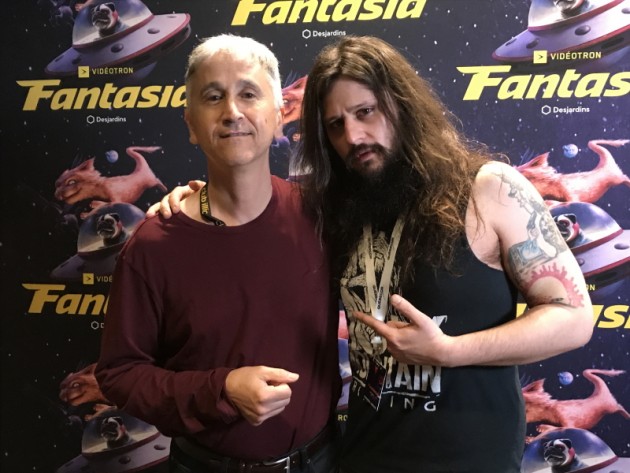
Author with Joe Begos
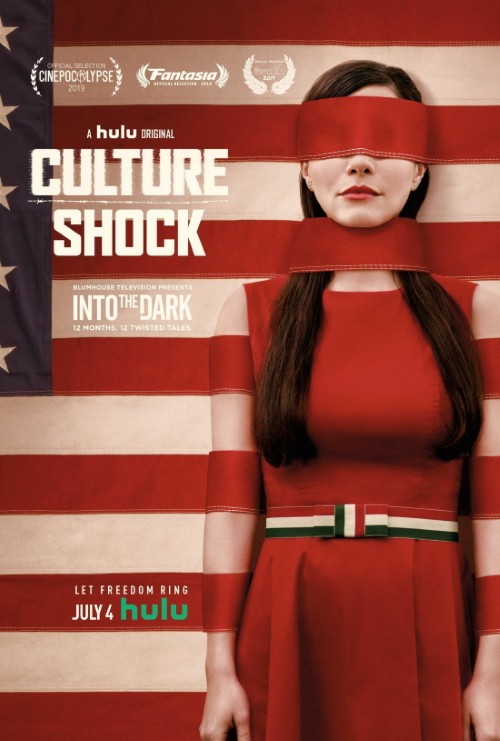
Culture Shock (Gigi Saul Guerrero, 2019) is the first feature by Mexican-born, Vancouver-based actor/director Gigi Saul Gerrero, which tackles border crossing horror in a tone that balances light satire and moments of garish horror, a Twilight Zone styled scenario where a Mexican woman’s hopes of living the American Dream turns to nightmare. The film is part of Hulu’s Blumhouse produced Horror TV series, Into the Dark, and ran as Episode 10 of Season 1. The director described her film as “Pleasantville gone wrong”. A pregnant Mexican woman named Marisol (Martha Higareda) (raped by a Mexican in the prologue) wants to leave Mexico for a shot at the American Dream. She is days away from giving birth and wants to leave so the child will be born in America. A mother-like doctor figure named Lupita wants her to stay and deliver her child in Mexico. Before she leaves Marisol and a few other Mexican women (Guerrero in a cameo) are spoken to by Lupita, who offers them contraception to prevent unwanted pregnancies. In the post-film Q&A Guerrero mentioned that this scene actually happens in Mexica and so is NOT fantasy or fiction. Lupita grants Marisol her blessings, who then pays to be taken to the border, where she is attacked by Mexican border guards working for the US government, where they are taken to a idyllic seeming gated community called Cape Hope. The idea of women and children being abducted resonates with the current situation in America around the making of the film, where immigrants deemed to be illegal are kept in cages and sometimes separated from their families. After being abducted Marisol wakes up to a garishly smiling close up of a whiter-than-white Barbara Crampton, delivering her child, bathed in a sickly glow of yellow, in a too good to be true gated community of robotic Pleasantville types, where Mexicans and other immigrants have been stripped of their ‘ethnicity’ to become as white, yellow and pastel as the set design around them, preferring pizza and hot dogs and apple pie to authentic Mexican food. The conceit is revealed when she wakes up on a slab tied to a Virtual Reality camera that has been feeding this propaganda reality into her mind. She escapes, with the help of Santo (Richard Cabral), and as the fireworks of the 4th of July blast the sky, the majority of Mexicans head off to the US while she returns home. A post credit scene echoes Spike Lee in BlackKklansman by aping real TV news, with Trump’s tweets on funding the Wall. Culture Shock may not be a great horror film but it is a great endorsement of how horror is a wonderful genre for playing out political alleogry. More specifically how Blumhouse productions is at the forefront of blending horror with politics (The Purge series, Get Out, Ma). Watch this and the I dare you to say horror is not political. The scary places where these immigrants are being detained in the US feeds the VR labs that Guerrero takes great care to film in drab, dreary style.

Culture Shock
Part of Fantasia’s growth has been in the addition of special screenings, presentations, live acts, performance pieces, conferences, master classes, theatrical shows, and other similar events, like the night with film critic, writer, TV host and B-Movie ambassador Joe Bob Briggs, entitled “How the Rednecks Saved Hollywood.” One could be forgiven, given Briggs’ Texas-sized love of exploitation, for expecting a regurgitation of the standard red neck lexicon. But Briggs’ aim was more nuanced, exposing some of the baser stereotypes of red neck culture to then reveal the considerable contributions red necks have made to American Popular culture.
This talk was one that Briggs has honed over the years and the research shows in the breadth of coverage. Briggs is a fine public speaker, talking fluidly, fast but never to the point where words jumble into each other. His talk was very well researched and there was a good mix between an historical/educational perspective and pure entertainment. He blends in a funny line or joke every few minutes or less to counterbalance the dryer material (though there is not much of that). The talk ran about 100 minutes and was spiced with clips, stills and poster art (lots of it). The talk begins with a history lesson that establishes the source of rednecks being the Cumberland Presbyterian Church along the Cumberland River Valley area. In an interview he explains the origins: “The redneck heritage all comes from Scots-Irish. So it’s people that came over to America to escape all the crap they were going through in Scotland and Ireland. As their culture evolved, they spread out down through Pennsylvania, Virginia, North Carolina, Georgia, and then they spread out west — Alabama, Mississippi. Not so much Louisiana — that was more French people. So they jumped over those people and went to Texas (laughs). … You find them all through America, though, because there was so much redneck migration in the 18th century.” (Briggs)

Author with the VERY tall Joe Bob Briggs
His selection of clips ranged from early cinema to today’s reality TV, which is really where, Briggs claims, rednecks have dominated and infiltrated mass culture. His main point or direction is how the redneck has always been a popular presence in the mainstream media, from Amos and Andy, Lil Abner, the film series Ma and Pa Kettle. While Hollywood has run the gamut of easy picking villains, from the KKK, the Nazis, the Commies, the Arabs, the one constant because they don’t have any defenders or apologists (no political correctness here) are the rednecks. But what has quietly happened below the radar (because no one outside the redneck areas admits to watching redneck shows) is that the rednecks have become really popular. They still appear as villains in rural horror scenarios, but they have created a larger niche of good old fashioned aw shucks folk. And they have for a long time. Briggs cites the popularity of the Ma and Pa Kettle series in the 1940s, the Ernest movies in 1990s and the truckload of rednecks populating the reality TV landscape (this is where Briggs ran through an illustrated list of shows featuring rednecks that was pretty mind boggling, with nature shows, crocodile hunting shows, car shows, looking for Big Foot shows, BBQ cooking shows, etc.). After the show I briefly spoke to Briggs and added to his point of the mainstreaming of the redneck by mentioning the hugely successful Cars animated films, which have as one of their most popular characters, the gap-toothed pick-up truck coded-as-redneck Matar, voiced by Nebraskan Larry the Cable Guy.
To illustrate the stereotype of the ‘feeble-minded’ redneck he shows slides from To Kill a Mockingbird, which featured the debut performance of Robert Duval. Duval returns with what Briggs thinks is one of the most authentic redneck portrayals in American cinema, the character played by the same Duval in Tender Mercies, showing us the scene where he is baptized as a middle aged man. Although his point is not to completely redeem the redneck –you can say that being a Texan he is in his right to defend or critique. But as he said, he does not consider himself to be, what the British define him as when he appears across the pond, a ‘satirist’ (pronounced by Briggs a “sadderist”, partly because the word makes people’s eyes glaze over!).
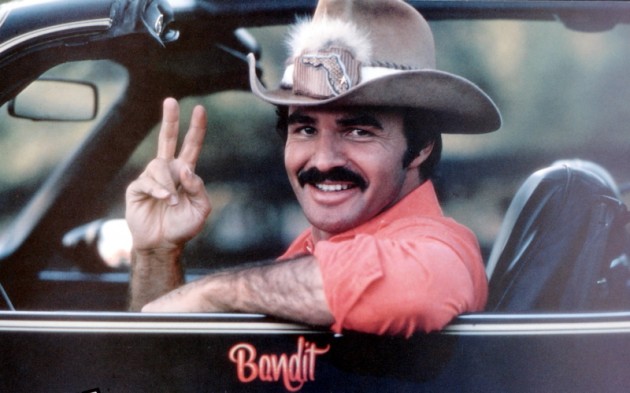
Burt Reynolds in one of the best redneck films, Smokey and the Bandit
His goal is to really give the redneck a fair shake at the entertainment landscape by acknowledging the contributions they have made which have often gone unnoticed by the ‘liberals’, while outing the good and bad stereotypes. For example, he much prefers the wisdom of Billy Bob Thornton’s character in Sling Blade to the “life is like a box of chocolate” wisdom spouted by Hank’s Forest Gump. He champions the heyday of Burt Reynolds’ great run of redneck classics in the 1970s and 1980s (White Lighting, W.W. and the Dixie Dancekings, Gator), praising Smokey and the Bandit as “the greatest film ever made” and the Sam Peckinpah trucker film Convoy. Key tropes in the redneck filmology: whiskey (or moonshine), women wearing super tight cut-off jeans, ‘feeble-minded’ characters as a result of in breeding, and a few others. Jan Michael Vincent’s White Line Fever is cited (but not Macon County Line or I Walk the Line). He opens with the Ving Rhames rape by redneck scene in Pulp Fiction, as a book-end to the famous Ned Beatty rape in Deliverance, which he doesn’t show (probably because it is the one scene EVERYONE in the audience knows). He prefers to show the ‘dueling banjos’ scene –and correctly wonders why it is called that when it is clearly a banjo vs. guitar (redneck logic???)! The Texas Chainsaw Massacre is praised, although he opts for a trailer compendium of poor quality rather than a clip. He shows the clip from In the Heat of the Night where Sydney Poiter’s Mr. Tibbs slaps the white man back and then leaves. The white man, who first says he could have had him killed for that in the good old days, then cries like a baby man. Briggs clarifies, he is not a redneck but a once privileged slave owner, and redneck never owned slaves! He shows an unnamed clip starring Lee Marvin and Richard Burton, and asked if anyone knows the title, to which I proudly yell, “The Klansman”. He mentions Mississippi Burning and makes a funny aside after a few Mississippi set films, claiming the reason why so many films are set there is because nothing has changed in terms of updating homes, buildings, streets, etc.! “You want a shop from 1937, well we can take you into town and open up old Pa’s store!” The talk was not exactly at the professorial level but Briggs is a clever adjudicator if not apologist of redneck culture. And as a slice of movie lore entertainment it was bang on fun. Darn gosh, who would have thought Fantasia would help set the record straight on red neck culture!



